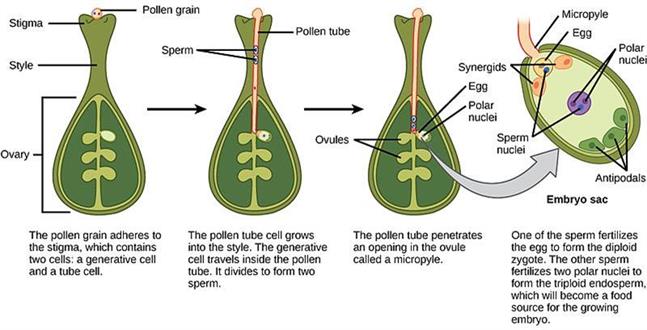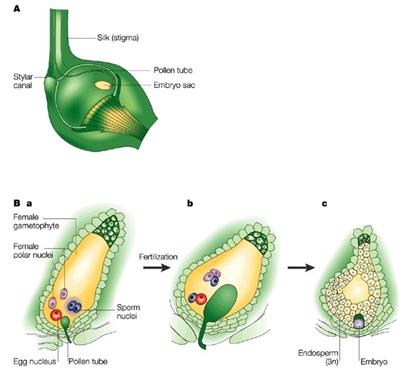
PUMPA - SMART LEARNING
எங்கள் ஆசிரியர்களுடன் 1-ஆன்-1 ஆலோசனை நேரத்தைப் பெறுங்கள். டாப்பர் ஆவதற்கு நாங்கள் பயிற்சி அளிப்போம்
Book Free DemoThe process by which a male gamete fuses with the female gamete to form a zygote is called fertilisation.
The process of fertilization in plants:

Fertilization
- The pollen grains from the anther fall on the stigma, they absorb a sugary substance and begin to swell and finally germinate.
- The pollen grain develops a small tube-like structure known as a pollen tube by rupturing the intine. It then arises from the germ pore present in the exine. All the components of the pollen grain move into the tube.

Development of pollen tube
- The pollen tube secretes an enzyme that helps in the dissolution of the tissue of the stigma.
- The pollen tube developed grows through the stigma and style tissues and eventually reaches the ovule via the micropyle.
- The vegetative cell degenerates inside the pollen tube, and the generative cell splits into two pollen grains (male gametes) by mitosis.
- On reaching the embryo sac of the ovule, the tip of the pollen tube bursts and the two pollen grains inside the tube enters the embryo sac.
- After the entry of the sperm, one sperm fuses with the egg (syngamy) to form a diploid zygote, and the other sperm fuses with the secondary nucleus (triple fusion), the triploid primary endosperm nucleus (PEN).

Double fertilization
- As two types of fusion such as syngamy and triple fusion, takes place in the embryo sac. This process is known as double fertilization and is seen only in angiosperms.
Reference:
https://commons.wikimedia.org/wiki/File:Figure_32_02_07.jpg
https://commons.wikimedia.org/wiki/File:Pollen_Tube.svg
https://upload.wikimedia.org/wikipedia/commons/a/af/Double_Fertilization.jpg